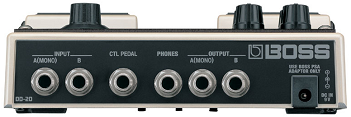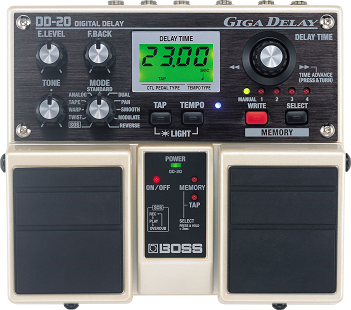Difference between revisions of "DD-20"
m (→General Information) |
m (→Controls) |
||
| Line 28: | Line 28: | ||
* Button 1 - '''"Tap"''': | * Button 1 - '''"Tap"''': | ||
* Button 2 - '''"Tempo"''': | * Button 2 - '''"Tempo"''': | ||
| − | ** Buttons 1 & 2 together: '''"Light"''': | + | ** Buttons 1 & 2 together: '''"Light"''': This controls whether the backlight on the digital display is on or off. |
* Button (red) 3 - '''"Write"''': | * Button (red) 3 - '''"Write"''': | ||
* Button 4 - '''"Select"''': | * Button 4 - '''"Select"''': | ||
Revision as of 04:05, 1 March 2018
Boss DD-20 GigaDelay. The Boss DD-20 has since been obsolesced by the Boss DD-500
Controls
- Knob 1 - "E. Level": (Effect Level)
- Knob 2 - "F. Back": (Feedback)
- Knob 3 - "Tone": Turned fully counter-clockwise this knob emphasizes bass; turned fully clockwise emphasizes treble frequencies in the delayed signal.
- Knob 4 - "Mode": Delay types:
- Sound on Sound (SOS) - "sampler" Record loops and then record on top of the loop you've already recorded.
- Twist
- Warp
- Tape
- Analog
- Standard
- Dual
- Pan
- Smooth
- Modulate
- Reverse : A reverse-gated delay sound, makes your instrument sound like it's being played on a tape or record being spun backwards.
- Knob 5 - "Delay Time":
- simple knob-turn: speed up or slow down delay on order of milliseconds.
- push-down and knob turn: speed up or slow down delay on order of hundreds of milliseconds.
- Button 1 - "Tap":
- Button 2 - "Tempo":
- Buttons 1 & 2 together: "Light": This controls whether the backlight on the digital display is on or off.
- Button (red) 3 - "Write":
- Button 4 - "Select":
- Footswitch 1 (left) - "On/Off": This turns the pedal On and Off
- Footswitch 2 (right) - "Select": This selects from each of the 4 banks
Input and Output Jacks
- Input A (mono)
- Input B
- Control Pedal input
- Headphones Out
- Output A (mono - dry + wet)
- Output B (stereo or only Input B)
- AC Adapter input
If only Input A has a instrument plugged in, it's possible to use Output A and Output B. Output A will be the "dry" signal and Output B will be the "wet" signal with all the delay repeats.
If Inputs A and B have instruments plugged in, Output A will have the dry + wet signal for Input A, while Output B will have the dry + wet signal for Input B.
Output Modes
- DD-20 is set to accept a basic instrument. Input A expects a -10 dB "instrument" level signal
- Use this mode when the delay is being used between an instrument and an amplifier
- -10 dB Basic instrument level signal, Output A = Dry, Output B=Wet
- Use this mode when you have separate instruments or separate signals for Input A and B, and Output A and Output B are individually going to separate amplifiers.
- Example: 1 instrument into a chorus pedal with stereo outputs, and then plugging the left chorus output into DD-20 Input A and the right chorus output into DD-20 Input B.
- Use this mode when you have separate instruments or separate signals for Input A and B, and Output A and Output B are individually going to separate amplifiers.
- DD-20 is set to expect 4 dB signal into Input A. This function can be enabled at Power-On by pressing down the left pedal down plugging in the AC adapter
- Use this mode when the DD-20 is being used in an amplifier's effects loop.
- DD-20 is set to expect 4 dB into both Inputs.
- Technically it's possible to use the DD-20 in two amplifier effects loops, with each loop using a single input and output before returning to their respective amplifier effects loops returns.
General Information
It's interesting to note that for 40 years Boss has been successful with pedals employung broad "metal cap/flap"-style footswitches. Dunlop/MXR, Digitech/DOD and the legions of boutique and home builders seem to have put Boss on the defensive and now Boss has returned to their CE-1 era button-style footswitches.
Modifications
http://music-electronics-forum.com/t16606/
Looping Features
Sound-on-Sound mode.
Pedal Manual
https://static.roland.com/assets/media/pdf/DD-20_OM.pdf
Phase Inversion
No schematic means that we're unable to determine, without an oscilloscope, if the DD-20 inverts the signal phase. That said, the schematic is probably so complicated that it would be almost impossible for the lay person to be able to trace and determine whether this pedal inverts. Once we get it up on a bench with an oscilloscope, we'll report here if the phase is inverted.
Schematic
None available.
Artists
- Additional Sources

